Excerpts from Jim Conrad's
Naturalist Newsletter
Entry dated May 24, 2024, issued from near Tequisquiapan; elevation about 1,900m, (6200 ft), ~N20.57°, ~W99.89°; Querétaro state, MÉXICO
HYBRIDELLA GLOBOSA
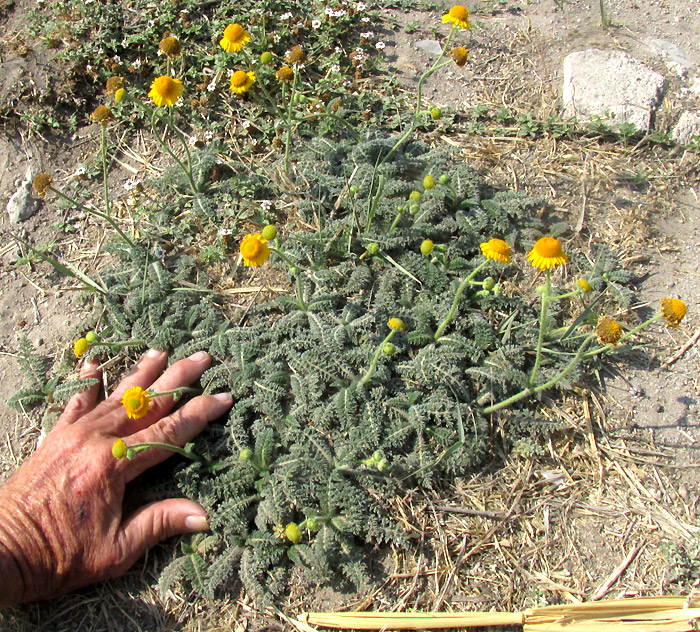
The above lived in a shallow valley filled with alluvial soil eroded from surrounding hills earlier vegetated with mesquite-dominated, semi-arid scrub. Now the valley floor was planted with irrigated crops, mostly alfalfa for feeding cattle. Our plant and the white-flowered Frogfruit flowering behind it were the only flowering species along a narrow dirt road crossing the valley. During the current long-running weather pattern classified by the North American Drought Monitor as the droughtiest kind of drought, a D4 one -- beyond D2 Severe and D3 Extreme -- these plants clearly are drought tolerant.

Flowering stems arose from the center of rosettes of feathery leaves at the base. For identification purposes it was important to notice that the flowering heads were arranged on branching stems, not within branching inflorescences. That's because the stem-like peduncle immediately below each head bore an emerging leaf, not a scale-like bracteole; they were identifiable as leaves and not bracteoles because the were compound and ferny like the basal leaves, not scale-like.
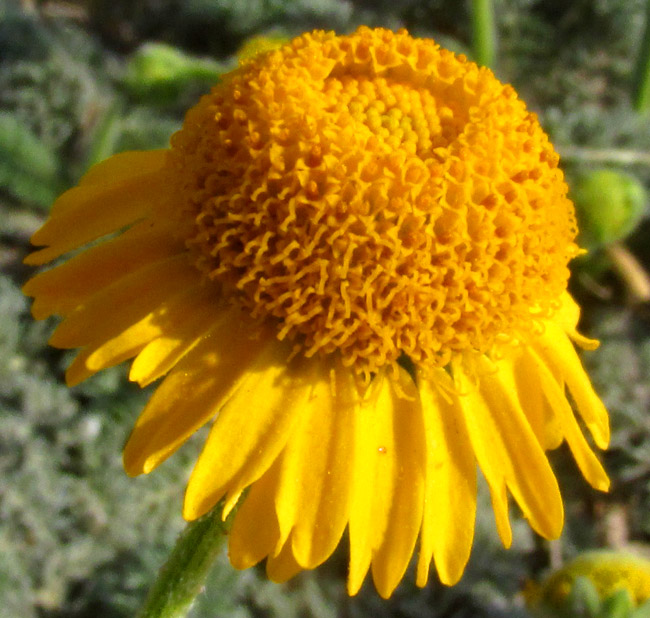
All visible details were sought not only was our plant a member of the largest, most diverse of plant families, the Composite/Aster/Sunflower Family, the Asteraceae, thus with lots of yellow-flowere options to choose from, but also because the plant displayed a curious combination of features I'd not seen on other plants. One striking peculiarity was the flowering head's pumpkin-shaped center part wearing a shaggy hula skirt.
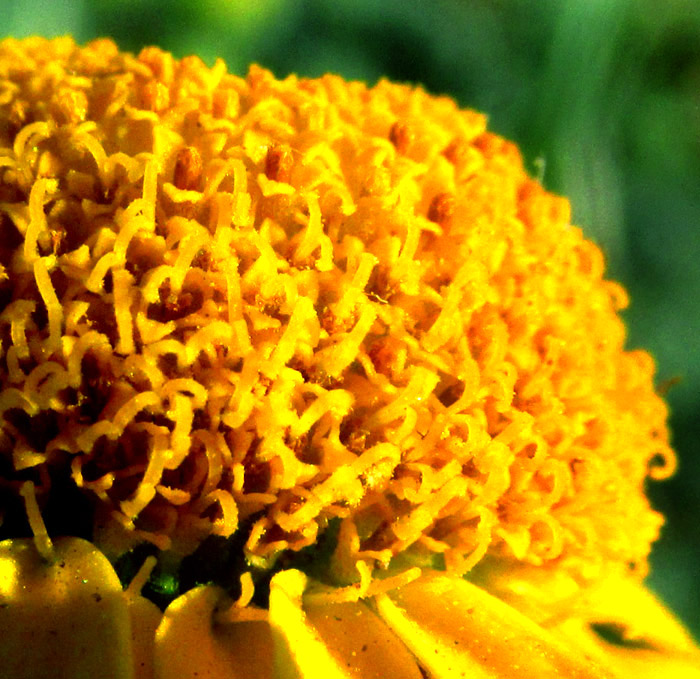
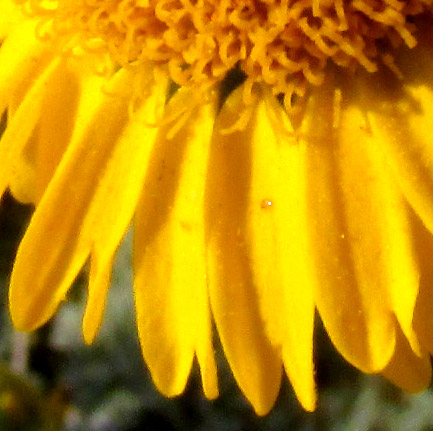
Above, Y-shaped style branches of both disc and ray florets were somewhat square-tipped, almost knobby, not sharply tipped as in many genera of the family. The cylindrical disc-floret corollas were 5-lobed, not 4. At the right, a very helpful field mark was that each ray floret corolla was deeply indented or incised at its tip.
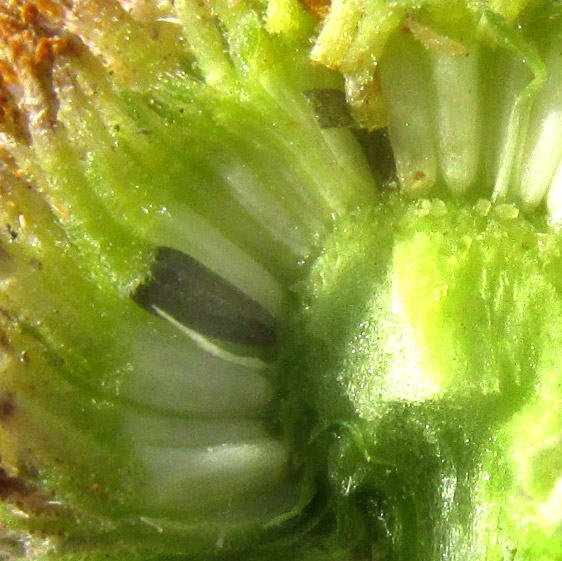
A broken open head, or capitulum, revealed that the disc florets stood atop a humped-up, hemispherical receptacle. White ovaries matured into black, one-seeded, cypsela-type fruits. Each floret was accompanied at its base by a narrow, scale- or scoop-like palea. That's important, for most species in the family produce different kinds of paleae, or no paleae at all. Equally diagnostic was that atop each cypsela, there was no pappus -- no crown of white hairs, scales or needlelike awns.

The florets were subtended by a green involucre composed of numerous scale-like bracts of similar but not identical lengths. The overlapping bracts were arranged in two or three spirals, rounded at their tips, and quite hairy.
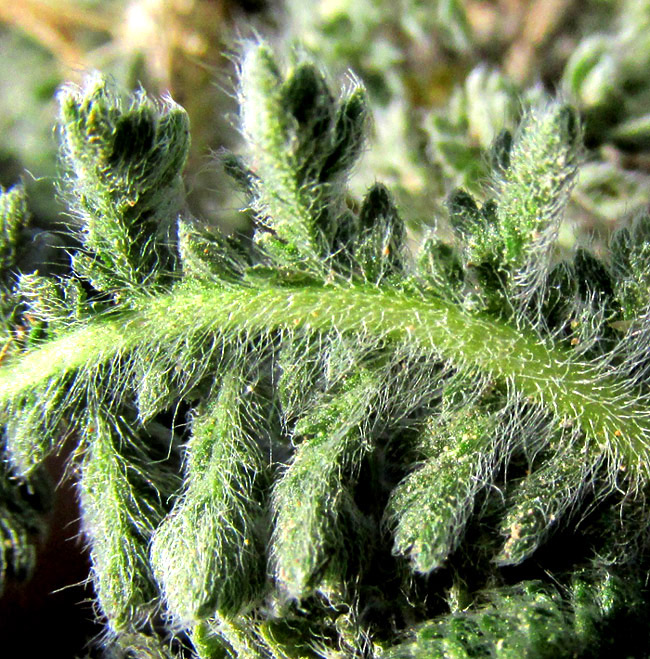
The leaves, still young and expanding, were pinnatisect -- pinnately divided so that the slender subdivisions were separated from one another nearly to the midrib, but not separated enough to form distinct leaflets. The leaves, like all the plants vegetative parts, were heavily covered with long, white hairs, which surely not only reflected the very intense sunlight but also inhibited loss of water.
The leaves were very similar to those of the common weed Yarrow, and like Yarrow's leaves, emitted a medicinal odor when crushed. However, the flowering heads were very dissimilar. The hemispherical centers of each head were typical of the sneezeweeds, such as the Bitter Sneezeweed, also with strong-smelling leaves, but sneezeweed heads produce no scale-like palea beside each cypsela, plus sneezeweed florets bear scales atop their cypselae forming pappi.
Based on such technical features as our plant's cypsela bearing no pappuses, but with each cypsela having beside it a scale-like palea, eventually our plant was identified as one of two species of the genus Hybridella. That genus occurs only in upland central Mexico, and currently incorporates only two species. Of those two Hybridella species, if the stems rise erect and the ultimate leaf segments are less than 1mm broad (3/64ths inch), you have HYBRIDELLA GLOBOSA, with no English name.
Hybridella globosa is endemic just to upland parts of a few central Mexican states. Despite our plants matching Internet images identified as Hybridella globosa, I hesitated to accept the name for two reasons. First, most photos show later-flowering plants with most leaves on erect stems, rather than our plants' stems arising from rosettes of leaves at their bases. Second, invariably the taxon is described as occupying wet habitats such as in marshes, sumps in low-lying wastelands, along sandy river banks, etc.
The more-than-extreme drought we're experiencing, accompanied by temperatures higher than normally are seen at this elevation may account for our plant's rosette of basal leaves. Possibly when a brief and inadequate rain did occur a couple of months ago, our perennial herb bolted, and since that rain the plant's vegetative parts haven't been able to develop further. Also it's to be noted that later in the year, when the species usually flowers, historically we've experienced a rainy season, during which this flat area may well have been swampy. Interestingly, the above frogfruit also normally inhabits moist to wet soils, but here it is with our Hybridella amid all this dusty, sunburned, overheated and dead-looking, parched landscape.
Another reason for confidence in this identification that John Olsen's 1977 work "Re-establishment of the Genus Hybridella (Asteraceae: Heliantheae)" describes the species in detail, with a drawing, and our plant fits the description perfectly.
I find no traditional medicinal use of Hybridella globosa. However, a 2010 study by B.I. Juárez-Flores and others entitled "Efecto de polvos de asteráceas sobre el gorgojo del maíz (Sitophilus zeamais Motsch)," found that dusts made from leaves of our plant killed 64-88% of Maize Weevils kept in jars for several days. Maize Weevils ruin traditionally stored corn, or maize, in the central Mexican highlands.